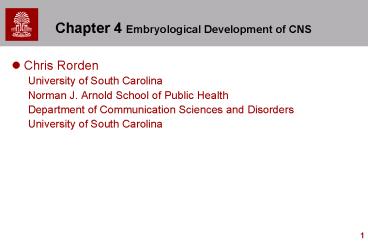Chapter 4 Embryological Development of CNS - PowerPoint PPT Presentation
1 / 33
Title:
Chapter 4 Embryological Development of CNS
Description:
Norman J. Arnold School of Public Health. Department of Communication ... Anencephalic. 28. Anencephalic Newborn. 29. Spinal Bifida. Spinal Bifida Cystica ... – PowerPoint PPT presentation
Number of Views:1460
Avg rating:5.0/5.0
Title: Chapter 4 Embryological Development of CNS
1
Chapter 4 Embryological Development of CNS
- Chris Rorden
- University of South Carolina
- Norman J. Arnold School of Public Health
- Department of Communication Sciences and
Disorders - University of South Carolina
2
Chromosomes and genes
- Humans have 46 Chromosomes
- 22 pairs are alike in both sexes
- 1 pair determines sex
- X (female) or Y (male)
- Genome is all DNA in all chromosomes
- A Gene is the sequence of DNA required for a
product to be expressed (proteins, enzymes)
Chromosome during division
3
Types of Division
- Mitosis
- For general body growth and function
- Regularly occurring for much of our body during
our entire life - Meiosis
- Special division during reproduction
4
Gametogenesis (involves meiosis)
- Process of forming reproductive units
- Gametes
- Male Spermatozoa
- From puberty through adult life
- Female Ovum
- Completed prior to birth 2 million
5
Zygote (fertilized egg)
- Produced from combination of male and female
parent chromosomes - Mitotic Division Begins
- New Cells called Blastomeres which form a Morula
Two-cell Stage
Four-cell Stage
Morula 3 days
6
Morula
- Morula develops central cavity called Blastocyst
- Blastocyst attaches to uterine wall
- One week from fertilization to implantation in
uterine wall - Allows blastocyst to get nutrients and excrete
waste products
7
Blastocyst
- Embryoblast
- Blastocyst
- Trophoblast
8
Blastocyst
Uterine stroma
Trophoblast cells
Embryoblast
Blastocyst cavity
9
The first week
10
The second week Bilaminar Embryo
- Embryo has two primary layers Epiblast
Hypoblast
Cytotrophoblast
Amniotic Cavity
Epiblast
Hypoblast
Primary Yolk Sac
Exocoelomic Membrane
11
Third week Trilaminar Embryo Develops
12
Week 3
- Embryo Trilaminar three layers between amniotic
cavity and yolk sac - Ectoderm future covering (skin, nails, hair,
but also CNS) - Mesoderm future muscles, bones, heart
- Endoderm future digestive tract
13
Week 3
- Primitive Streak Forms dorsally
- Forms neural tube, notochord (cartilaginous rod,
future spine) and neural crest cells
14
Presomite Embryo 18 days
Cut edge of amnion
Neural plate
Primitive pit
Primitive streak (mesoderm)
15
Early Highlights
- Day 18 - Neural plate invaginates (encloses) to
form neural groove - Day 22 - Neural Tube Forms
- Becomes brain and spinal cord
- About the same time, Neural Crest Forms
- Becomes cranial and spinal nerve ganglia
16
Presomite Embryo 20 days
Cut edge of amnion
Neural groove
Somite
Primitive streak
17
Neural Tube
- Anterior 2/3 will form brain
- Caudal 1/3 will form spinal cord
- Day 25 - Cranial opening closes
- Brain has 3 sections
- Prosencephalon
- Mesencephalon
- Rhombencephalon
- Day 27 - Caudal end closes
- Problems cause neural tube defects
18
Human Embryo 22 days
Neural fold
Optic placode
Somite
Cut edge of amnion
19
Human Embryo 23 days
Cranial neuropore
Pericardial bulge
Caudal neuropore
20
Week 5
- Prosencephalon Develops
- Telencephalon (cortex)
- Diencephalon (thalamus, hypothalamus)
- Mesencephalon Develops (mid brain)
- Rhombencephalon
- Metencephalon (pons, cerebellum)
- Myelencephalon (medulla)
21
Telencephalon
- Optic Vessels - retinae, optic nerve
- Cerebral Hemispheres - Lateral Ventricle
- Medial Connection Corpus Callosum
- Olfactory Lobe
- Corpus Striatum
- (Caudate N. Lenticular N.)
- Cerebral Cortex
- Very primitive though 20 weeks
22
Third Trimester
- All structures present at birth
- All structures become more distinct in Third
Trimester - Commissures develop
23
Seven Steps of CNS Development
- Production of initial neurons and glial cells
- Migration of cells to definitive location
- Selective gathering of cells to functional group
- Cytodifferentiation (axon, dendrite, synaptic
patterns) - Selective death of some cells in groups
- Outgrowth of axons to specific target cells and
establishment of connections - Elimination of certain connections and functional
stabilization of others
24
Maturation of CNS
- At birth, all neurons you will ever have present.
- Only a few exceptions (neurons involved w smell)
- Process of myelination signals onset of mature
function - Slow process
- Partially completed completed by age 7
- Axons and dendrites not until teens
- Some areas continue to age 70
- Some cells have programmed cell death (Apoptosis)
- tadpoles lose their tails and pigeons' feet
become unwebbed. Crucial in brain - Note not all developmental language disorders
present at birth.
25
Myelin Sheaths
- Short Gaps (Nodes of Ranvier) on Axons
- Speed up neural activity
- In CNS, formed by Oligodendrocytes
- Type of Glial Cell
- In PNS, formed by Neurilemmal or Schwann cells
26
Rate of Myelination Varies
- Spinal tract completed by 9th month
- Major motor tracts by 2 years
- Cerebrum and Cerebellum into the teens
27
Abnormal Development
- Anencephaly
- Cerebral Hemispheres reduced or missing
- More common in Females
- Cranial Bifidum
- Bone fusion presented by brain or spinal cord
protruding through skull
Anencephalic
28
Anencephalic Newborn
29
Spinal Bifida
- Spinal Bifida Cystica
- Portions of the meninges or neural tissues not
enclosed by posterior vertebral arches - Spina Bifida Occulta
- Dimple on spinal column on top of an opening in
between vertebrae
30
Other Developmental Conditions
- Hydrocephaly
- Enlarged head, brain atrophy mental deficiency
- Excessive production of CSF or obstruction of
drainage pathways - http//neurosurgery.seattlechildrens.org/condition
s_treated/hydrocephalus.asp
31
Causes of hydrocephalus
32
Hydrocephalus Treatment
- Many adults had developmental hydrocephalus with
no problems - Others need urgent surgery
33
Microcephaly
- Brain and Skull cap are small
- Face is normal
- Mental Retardation































